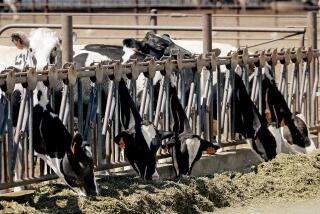Measles Outbreak Plagues 23 States; Funds Run Short
The measles outbreak now plaguing California is part of a larger, two-year epidemic that health officials say is sweeping the nation, causing thousands of cases of illness and scores of deaths.
From Maine to Texas, Alaska to Florida, there have been serious measles outbreaks in at least 23 states this year, and the number of reported cases is running about 70% ahead of last year at this time, health officials said. For 1989, the Centers for Disease Control in Atlanta reported 17,800 measles cases and 45 deaths.
By April 6 this year, at least 31 measles-related deaths had been reported nationally, 24 of them in California, and the “measles season” of late winter and early spring, is not yet over, officials said.
State after state has turned to the Centers for Disease Control in Atlanta for additional money for vaccine to immunize vulnerable populations. Consequently, $9.5 million in special federal funds allotted this year for outbreak control is already gone, CDC officials said.
“We sent the last of the money out today,” Dr. William Atkinson, a CDC epidemiologist who has been monitoring the nation’s measles outbreak, said Thursday. “We’ve asked the government for a supplemental appropriation. Until we get it, people will just have to wait or they will have to go to their state legislature.”
Most states say they have adequate supplies of vaccine on hand. But, they said, they are being cautious with their remaining stores.
“At this point, we’re running nip and tuck, kind of hand to mouth in order to immunize all the people who need to be immunized,” said B. J. Laing, a nursing consultant for the Nevada Department of Social and Health Services.
“We’ve got enough at the moment for outbreak control,” said Dr. Mack Sewell, New Mexico state epidemiologist, “but we’re being very judicious about how we use it. We have to be careful because of the limited supply and the amount of funds we have.”
Rick Nelson, a public health adviser in Washington, said he’s keeping his fingers crossed that Merck, Sharp & Dome, the only federally approved manufacturer of measles vaccine, can keep up with the demand.
“The worse case scenario is that we may be two or three days in getting the vaccine into the areas,” said Gary Bruell, spokesman for the West Point, Pa., company. “But we’re getting it there as fast as we can.”
So far, most of the nation’s outbreak has been concentrated among preschool children, either because parents failed to have them vaccinated against the disease or because they contracted the disease prior to the recommended immunization age of 15 months, officials said.
In Chicago, an estimated 30% of preschoolers have not been vaccinated, officials said, and Atkinson of the CDC believes those numbers are probably reflective of other major urban ares.
Rep. Henry A. Waxman (D-Los Angeles) has introduced legislation for a 40% increase in the $131.5 million allotted to the CDC to be distributed to states for immunization.
“We should eliminate any financial barriers and second we should reach out to bring people in to have their children immunized. It’s inexcusable that we should have people suffering,” Waxman said.
For most communities, the biggest problem is providing enough staff as health officials struggle to identify affected pockets and to vaccinate susceptible residents. In Washington state, local health departments in some cases have recruited Boy Scout troops to go door to door handing out flyers urging that residents be immunized.
In St. Paul, Minn., which has had 117 reported measles cases since January, compared to seven cases for all of last year, department officials have been forced to pull staff from other departments, hire additional workers, recruit volunteers and enlist the services of a home health care agency to meet the demand for immunization.
“We’ve never had this type of an outbreak in recent years,” said epidemiologist Dr. Paula Henry.”
In Dallas, which has already reported 1,600 cases of measles, five times last year’s number, and four deaths, health department officials have been working almost around the clock, said county epidemiologist Charles Haley.
“We’ve had to drive our staff past any reasonable limits,” Haley said. “In the month of February, we immunized more people than we did in all of 1989, and in the first 10 days of March, we immunized more than we did in February. And that’s with no additional staff.”
While the current outbreak pales in comparison to the pre-vaccine era when measles cases numbered 500,000 to a million annually, health officials say they are concerned because of the highly contagious nature of the disease in what has become a more mobile national population.
“You don’t have to even be in the same room to get the disease,” said Atkinson of CDC. “We know that an infected person can have left a room two hours ago, and you can walk into the room and catch the disease from the germs still floating around in the air.”
Officials have tracked cases that were passed on county-to-county and state-to-state via crowds in medical waiting rooms, at spring break and at weddings and other family gatherings. Health officials say many cases can be traced to Canada, Mexico, Nicaragua and El Salvador. More than 300 measles-related deaths were recorded in Mexico alone last year.
Officials say one reason that many young children have not been immunized is that the health care system has sometimes not made immunization easily accessible. Consequently, many communities are now considering changes in location of their clinics or the hours of operation.
But officials also warn that it is parents who ultimately are responsible for seeing that their children are immunized.
“We had one death where the parent lives six blocks from an immunization clinic,” said Haley in Dallas. “That wasn’t a problem of accessibility.”
“Fifteen-month-old children don’t walk into the clinic,” Atkinson added. “They have to be brought in.”
Health officials said part of the problem has been the inability of the health care system to educate many people, particularly recent immigrants, to the importance of immunization. That, they said, accounts for the disproportionate number of measles cases in Latino, non-English-speaking populations and other immigrant communities.
“We’ve polled people in our Hispanic community, and it’s an accepted thing in childhood that everyone gets the measles,” said Laing of the Nevada health department. “It’s a way of life, an expected happening. We’re trying to reach them through the media to let them know that we do have some prevention.”
Health officials report a similar situation in Minnesota, where the Laotian immigrants settled near St. Paul and Minneapolis following the Vietnam War, and in the Amish communities scattered throughout Iowa, New York, Michigan and Wisconsin.
“We’ve had a couple of hundred cases simply because the Amish people don’t believe in immunization,” said William Fagel, spokesperson for the New York Health Department. “Once it starts in a closed community like that, it spreads like wildfire.”
Adding to the outbreak, officials said, are a large number of measles infections in adults who have been vaccinated. Officials said that in about 5% of all those vaccinated against measles, the vaccination fails to take hold, or sometimes the protection wanes over time. That has accounted for large outbreaks of measles around the country in colleges and universities among young adults, who are most susceptible to the deadlier aspects of the disease.
In response, the U.S. Public Health Service and the American Academy of Pediatrics has recommended to public and private health providers that those born after 1956, particularly school children, college students, medical personnel and those in high-risk locations, be vaccinated at least twice to be sure that the vaccine takes hold.
While the federal government has made the recommendation, it has yet to make available additional funding to provide for a second dose.
“The federal government needs to fund the two-vaccine regimen,” said Sewell, the epidemiologist for New Mexico.
A double dose of vaccine would be ideal, health officials agree, but they said the key to the problem is the initial inoculation.
“If we could just get a single dose of vaccine into children by the time they were 6 months old,” said Atkins in Atlanta, “we’d have a fraction of the problem we’re having now.”
Researchers Janet Lundblad, Mary Kay Lewis and Tom Lutgen contributed to this story.
STATES REPORTING MEASLES OUTBREAKS
1990 1989 1988 State Cases So far Cases Cases Alaska 50 1 2 Arizona 150 180 4 California 1,868 3,048 835 Connecticut 40 229 14 Florida 189 323 170 Illinois 590 3,081 69 Indiana 230 115 58 Iowa 21 13 2 Maine 50 3 7 Maryland 64 115 19 Michigan 318 359 31 Minnesota 151 70 11 Missouri 48 671 61 Nevada 18 0 0 New Mexico 54 31 0 New York 265 337 150 Ohio 320 2,720 109 Oklahoma 132 110 8 Oregon 113 82 5 Pennsylvania 214 344 538 Texas 2,500 3,315 286 Washington 100 55 7 Wisconsin 420 880 4
Source: State health departments
More to Read
Sign up for Essential California
The most important California stories and recommendations in your inbox every morning.
You may occasionally receive promotional content from the Los Angeles Times.










